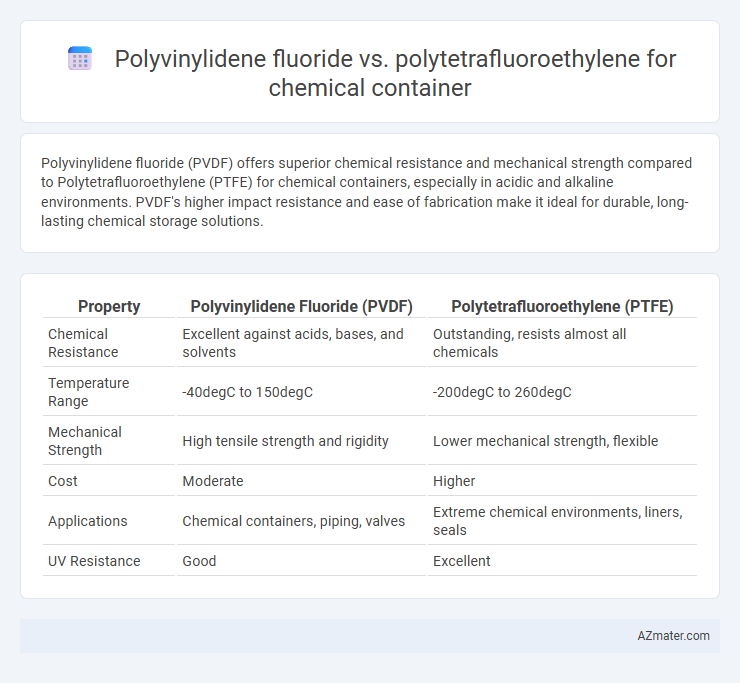Polyvinylidene fluoride (PVDF) offers superior chemical resistance and mechanical strength compared to Polytetrafluoroethylene (PTFE) for chemical containers, especially in acidic and alkaline environments. PVDF's higher impact resistance and ease of fabrication make it ideal for durable, long-lasting chemical storage solutions.
Table of Comparison
| Property | Polyvinylidene Fluoride (PVDF) | Polytetrafluoroethylene (PTFE) |
|---|---|---|
| Chemical Resistance | Excellent against acids, bases, and solvents | Outstanding, resists almost all chemicals |
| Temperature Range | -40degC to 150degC | -200degC to 260degC |
| Mechanical Strength | High tensile strength and rigidity | Lower mechanical strength, flexible |
| Cost | Moderate | Higher |
| Applications | Chemical containers, piping, valves | Extreme chemical environments, liners, seals |
| UV Resistance | Good | Excellent |
Overview of Polyvinylidene Fluoride (PVDF) and Polytetrafluoroethylene (PTFE)
Polyvinylidene fluoride (PVDF) offers high chemical resistance, excellent mechanical strength, and good thermal stability, making it suitable for demanding industrial chemical containers. Polytetrafluoroethylene (PTFE) excels with outstanding chemical inertness, extremely low friction, and a wide temperature resistance range, commonly used in applications requiring superior corrosion resistance. Both polymers provide robust containment solutions, but PVDF is favored for structural integrity while PTFE is chosen for maximum chemical non-reactivity and temperature tolerance.
Chemical Resistance: PVDF vs PTFE
Polyvinylidene fluoride (PVDF) offers excellent chemical resistance to a broad range of acids, bases, and solvents, making it ideal for aggressive chemical containers, especially with strong oxidizers and hydrocarbons. Polytetrafluoroethylene (PTFE) exhibits superior chemical resistance across nearly all chemicals, including highly corrosive substances like chlorine and fluorine, and can withstand higher temperatures without degradation. For chemical containers requiring maximum chemical inertness and thermal stability, PTFE outperforms PVDF, though PVDF provides better mechanical strength and impact resistance.
Mechanical Strength Comparison
Polyvinylidene fluoride (PVDF) exhibits higher tensile strength and better impact resistance compared to Polytetrafluoroethylene (PTFE), making it more suitable for chemical containers requiring durability under mechanical stress. PVDF's mechanical properties include a tensile strength of approximately 34 MPa, while PTFE typically shows a lower tensile strength around 21 MPa. The enhanced mechanical strength of PVDF allows chemical containers to maintain structural integrity under pressure and mechanical loads better than PTFE.
Temperature Stability and Thermal Properties
Polyvinylidene fluoride (PVDF) offers excellent chemical resistance and maintains thermal stability up to 150degC, making it ideal for chemical containers exposed to moderate heat. Polytetrafluoroethylene (PTFE) withstands higher temperatures, up to 260degC, with superior thermal properties and exceptional non-reactivity, suitable for aggressive chemical environments requiring elevated temperature resistance. PVDF provides better mechanical strength at elevated temperatures, whereas PTFE excels in extreme thermal stability and chemical inertness.
Permeability and Barrier Performance
Polyvinylidene fluoride (PVDF) exhibits lower gas permeability and superior chemical resistance compared to polytetrafluoroethylene (PTFE), making it an ideal choice for chemical containers requiring enhanced barrier performance. PTFE offers exceptional chemical inertness and thermal stability but tends to have higher permeability to gases and vapors, which may limit its effectiveness in preventing contamination or loss of volatile substances. The molecular structure of PVDF results in a denser polymer matrix, providing enhanced impermeability and longer service life in harsh chemical environments.
Durability and Lifespan in Harsh Environments
Polyvinylidene fluoride (PVDF) exhibits superior chemical resistance and mechanical strength compared to polytetrafluoroethylene (PTFE), making it highly durable for chemical containers in harsh environments. PVDF maintains structural integrity and resists cracking under extreme temperature fluctuations and aggressive chemical exposure, resulting in an extended lifespan. PTFE offers excellent chemical inertness but is more prone to creep and deformation, reducing its long-term durability in demanding industrial applications.
Cost-Efficiency and Availability
Polyvinylidene fluoride (PVDF) offers superior cost-efficiency compared to polytetrafluoroethylene (PTFE) for chemical containers due to its lower material and fabrication expenses while maintaining excellent chemical resistance. PVDF is more readily available in various forms and grades, enabling faster procurement and reducing lead times for manufacturing. PTFE, although highly resistant to aggressive chemicals and high temperatures, often comes at a premium price and limited availability, impacting overall budget and project timelines.
Safety and Regulatory Considerations
Polyvinylidene fluoride (PVDF) offers superior chemical resistance and complies with FDA and NSF standards, making it safe for storing aggressive chemicals in food and pharmaceutical industries. Polytetrafluoroethylene (PTFE) provides excellent non-reactivity and withstands a wider temperature range but may require more stringent handling due to its potential degradation at high temperatures releasing toxic fumes. Regulatory guidelines emphasize PVDF for applications demanding stringent cleanability and lower leaching risks, while PTFE is often favored where extreme thermal stability is prioritized.
Application Suitability for Chemical Containers
Polyvinylidene fluoride (PVDF) offers superior chemical resistance, especially against strong acids and bases, making it ideal for chemical containers requiring durability under aggressive conditions. Polytetrafluoroethylene (PTFE) excels in non-stick and low-friction properties, providing excellent inertness and temperature resistance but with less mechanical strength compared to PVDF. For chemical containers, PVDF is preferred when mechanical robustness and chemical resistance are critical, while PTFE suits applications demanding extreme chemical inertness and high-temperature stability.
Conclusion: Choosing the Right Material for Chemical Storage
Polyvinylidene fluoride (PVDF) offers superior chemical resistance, mechanical strength, and UV stability, making it ideal for aggressive chemical storage in harsh environments. Polytetrafluoroethylene (PTFE) excels in extreme temperature resistance and outstanding non-reactivity but has lower mechanical durability compared to PVDF. Selecting the right material depends on specific chemical compatibility, temperature requirements, and mechanical demands of the storage application.

Infographic: Polyvinylidene fluoride vs Polytetrafluoroethylene for Chemical Container
 azmater.com
azmater.com